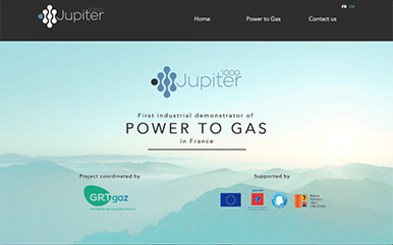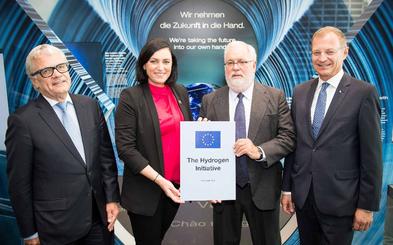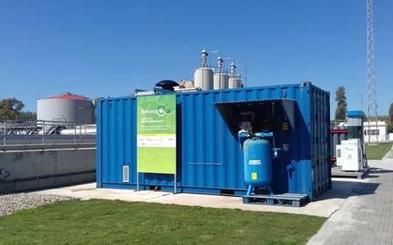INNOVATIVE PROJECTS PLATFORM
ENTSOG and its Members (TSOs) invites you to a new interactive platform called Innovative Projects Platform. To efficiently build on its Members efforts to promote or contribute to innovative technologies, regulation and business models, and partnerships across the value chain, ENTSOG have initiated the identification process to map TSOs’ partnerships on Research, Development and Innovation (RDI) activities.
The result is the creation of a public platform for communication and exchange of best practices applied at national level.
These innovative solutions focus on biogas, power to gas, hydrogen, CNG and other innovative applications to support the achievement of the current EU goals of reducing GHG emissions.
*Disclaimer: The content published on this page is information owned by TSOs and not by ENTSOG. It is therefore published on behalf of TSOs. Please note terms and conditions of use of the website (including article 7) are fully applicable to this page.
Technology
Discover here how technologies can optimise the usage of the grid, make digital layer connections and support decarbonisation of the EU gas system. Technology R&D has a vital role in the energy transition. ENTSOG Members (TSOs) are developing new and innovative technologies to offer sustainable solutions for the gas sector.
Regulation & business model
Stay informed on how ENTSOG Members (TSOs) engage in development of the new energy products and services to foster uptake of renewable and decarbonised gases into the grid.
Partnership
Look at new partnerships and initiatives formed by ENTSOG’s Members (TSOs). They are actively working together as well as with various stakeholders on projects aimed at decarbonisation of the gas sector and of the whole EU economy.
Hydrogen
Hydrogen can be produced from diverse process technologies. Hydrogen can be produced via steam methane reforming and blended with natural gas to be transported via existing grid infrastructure and contribute towards decarbonisation.
Innovation & Transition
Technological innovation is important for the transition to low carbon economy and combating climate change. New technologies such as power-to gas, biomethane, hydrogen, CNG will enable this transition.
Biogas
Biogas is obtained via the anaerobic decomposition of the organic matter. After the process of upgrading, biogas becomes biomethane with the same quality standard as natural gas and can be transported via the existing grid infrastructure.
CCS
Carbon Capture and storage is the process of capturing waste CO2 from large point sources, such as fossil fuel power plants, transporting it to a storage site, and depositing it where it will not enter the atmosphere. The aim is to prevent the release of large quantities of CO2 into the atmosphere.
Power to gas
Power-to-gas is the conversion of electrical power into a gaseous energy carrier like e.g. hydrogen or methane. This technological concept is considered to be an important tool in the energy transition.
CNG
Compressed Natural Gas (CNG) is a fuel source that is made from compressing natural gas to less than 1% of its standard atmospheric volume. CNG combustion produces fewer undesirable gases than other fossil fuels.
Digitalisation
Digitalisation can bring various benefits to day-to-day operations such as enhanced control over the gas quality and cost reductions. TSOs look at data-driven solutions to boost performance, efficiency and competitiveness.
Heating & Cooling
Cutting the energy consumption in heating and cooling in buildings and industry can be achieved through various technologies. TSOs are working on developing cost-efficient solutions for the decarbonisation of this sector.
Certification of green gases
To ensure the cross-border scale up and tradability of renewable, decarbonised and low-carbon gases. This can be achieved via pan European Guarantees of Origin and Certification Schemes.
Open Grid Europe GmbH
Hybridge
Amprion and Open Grid Europe (OGE) are joining forces to press ahead with intelligent sector coupling. The two companies are planning to trial the power-to-gas (PtG) technology on an industrial scale to help accelerate the energy transition. The aim is to build PtG plants in the 50 to 100 MW range. Potential sites in Lower Saxony and northern North Rhine-Westphalia have been identified.
Contact: karsten.frese@open-grid-europe.com,
jan.teuwsen@amprion.net
Gasunie, TenneT
Joint Infrastructure Outlook 2050
TenneT and Gasunie published their first Infrastructure Outlook 2050, which is the result of a joint study on the development of an integrated energy infrastructure in the Netherlands and Germany. It takes the target of the Paris Agreement (COP21) as a starting point. This Infrastructure Outlook describes the consequences of for the existing gas and electricity transport infrastructures in three scenarios. This Outlook 2050 represents a solid, joint start with fresh new insights and shows the requirements and the restrictions for the infrastructure relating to a future CO2-neutral energy system.
Contact: P.Nienhuis@gastransport.nl
Energinet, Gasunie
North Sea Wind Power Hub
TenneT Netherlands, TenneT Germany, Energinet, Gasunie and Port of Rotterdam joined to build an artificial island in the North Sea to host synergy technologies such as Power2Gas. The hub provides a basis for a joint European approach up to 2050 and focuses specifically on developing the North Sea as a source and a distribution centre for Europe’s energy transition.
Contact: til@energinet.dk
GRTgaz
FenHYx
FenHYx is a first demonstrator on a European scale to test hydrogen and decarbonised gases in the networks.The FenHYx platform in particular aims to reproduce the features of gas networks and especially those of the gas transmission networks: compression, expansion, measurement, analysis, injection loop, etc. The opening up of this platform to other operators will contribute to the emergence of the hydrogen sector.
Contact: jeanmarc.brimont@grtgaz.com
Energinet
ERGaR
ERGaR is founded as a cooperation between European registries of biomethane certificates that will enable cross border trade of biomethane certificates among the member registries. ERGaR will be the Europe-wide recognised organisation for administering and mass balancing volumes of renewable gases virtually distributed along the European natural gas network.
Contact: jbg@energinet.dk
Gasunie Deutschland Transport Services GmbH, Thyssengas GmbH
ELEMENT EINS
Gasunie Deutschland, Tennet and Thyssengas will plan a 100 MW power-to-gas-installation. Planned operation in different phases from 2022. It will become the biggest power-to-gas-installation in Germany.
Contact:
- Gasunie Deutschland - philipp.vonbergmann-korn@gasunie.de,
- Thyssengas - gerhard.huelsemann@thyssengas.com,
- TenneT - julia.weich@tennet.eu
Ontras Gastransport GmbH, SNAM Rete Gas S.p.A.
Linz Hydrogen Initiative
Austrian Presidency of the EU Council started the “Linz Hydrogen Initiative” and invited to a high level conference on the eve of the Informal Meeting of the Energy Ministers on 17 September. The conference focused on the topics of renewable hydrogen, energy storage technologies and innovative energy technologies for energy intensive industries.
Contact: ina.adler@ontras.com, dina.lanzi@snam.it
GRT GAZ, TERÉGA
Jupiter 1000
Teréga with GRTgaz developed a demonstration project for Power to Gas in Fos-sur-Mer. The aim of this initiative is to help shape this new sector by developing the technologies concerned, building the associated economic and regulatory models, and overcoming current technical reservations.
Contact: jeanmarc.brimont@grtgaz.com, cecile.boesinger@terega.fr

Enagás S.A.
RenovaGas
RENOVAGAS is a research project whose first phase finished in 2017. It first aim was the development of a 15 kW demonstration plant for the production of synthetic natural gas (SNG) from the electrolytic production of hydrogen with renewable energy sources (RES) and its combination directly with a biogas stream, that is, without separating CO2 from the methane, through a methanation process, so the synthetic natural gas obtained was fully renewable.
Contact: jrubio@enagas.es
Snam Rete Gas S.p.A.
Biogasdoneright
Snam, together with the Consorzio Italiano Biogas and Confagricoltura (CIB) has developed and presented a manifesto to the public in support of the Italian biomethane supply chain. CIB developed an innovative approach to produce sustainable biogas from winter crops called Biogasdoneright.
Contact: Simona.Dangelosante@snam.it










